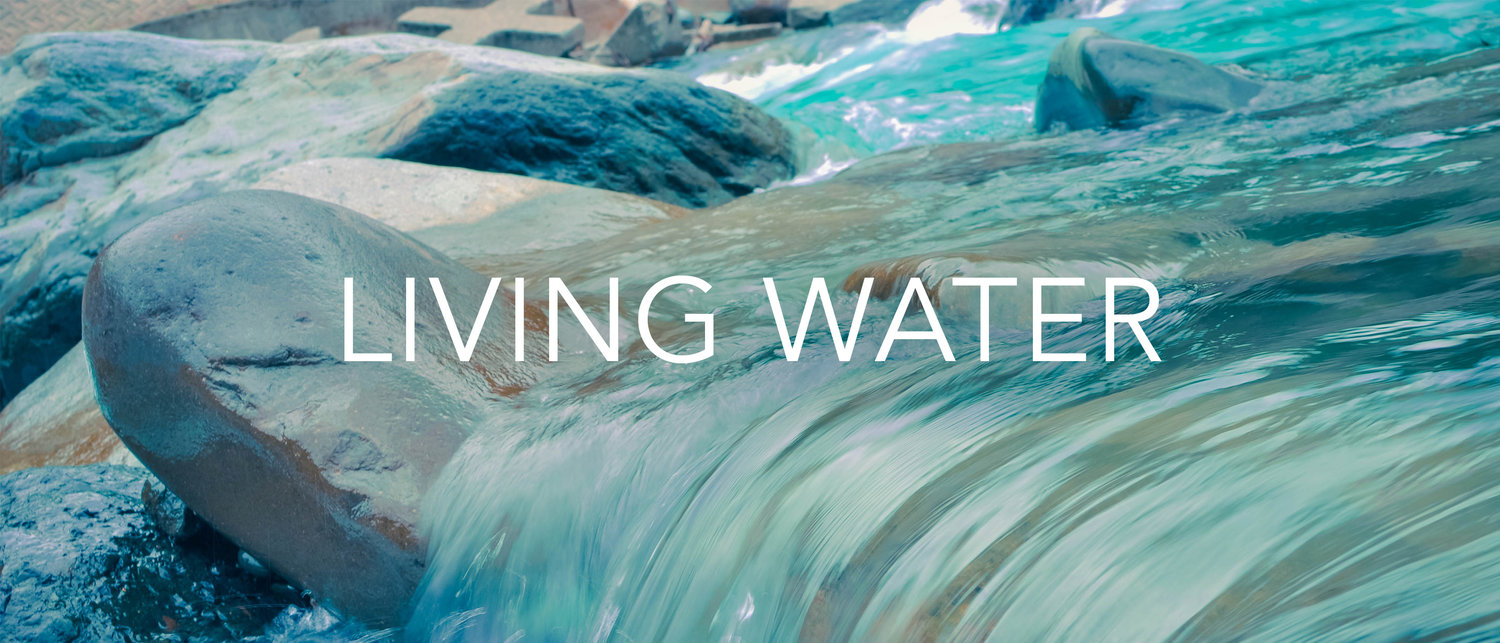
Living Water
This week we begin a four part series on the four elements. In the words of Richard Rohr,
When God manifests spirit through matter, then matter becomes a holy thing. The material world is the place where we can comfortably worship God just by walking on it, loving it, and respecting it. Everything visible, without exception, is the outpouring of God. What else could it really be?
Robin Wall Kimmerer, in her book Braiding Sweetgrass, tells the story of spending every summer canoe camping in the Adirondacks. Every day began with her father standing above the water in his red-checked wool shirt holding the battered tin coffeepot full of freshly brewed coffee. When he lifted the pot the family knew it was time to pay attention. Holding the top with a potholder, he would pour out some of the coffee and speak into the stillness, “Here’s to the gods of Forked Lake (or South Pond, or brandy Brook Flow.)” As a child, she came to understand that each place was “inspirited,” and was home to others before they had arrived and would be long after they left. In sharing that gift of coffee, her father taught them to respect the places they were traveling and to be grateful.
It was a simple homemade ceremony connecting the ordinary to the sacred, the people to the land to the spirits. All part of the sacred circle.
When learning Ojibwe, Robin came across the word wiikwegamaa: “to be a bay.” That didn’t make any sense to her. A bay was supposed to be a noun - a person, place or thing – not a verb. Then suddenly insight struck. A bay is a noun only if it is dead, trapped by the definitions of humans. If a bay is a verb, then it has “being” it “holds the wonder that, for this moment, the living water has decided to shelter itself between these shores, conversing with cedar roots and a flock of baby mergansers. Because it could do otherwise – become a stream or an ocean or a waterfall…the language is a mirror for seeing the animacy of the world.” And the sacredness of the world, the world infused with gift and God.
People have this unfortunate habit of considering humans as “beings” and relegating all else to substandard and therefore to be used for our own purposes.
Bringing animation to water, we recognize that water flows, nourishes, brings life, wears down rough edges, cleanses, refreshes, quenches, soothes and helps things to grow. Many of these things also describe God which is why God is sometimes referred to as a river or living water. There is a confusing thing that happens… water is sacred, is filled with the divine as part of creation, AND the divine is like water in so many ways. Either way you look at it allows us to broaden our experience of God in the material world, and have a deeper understanding of God through the metaphor.
I want to talk about Jesus and the woman at the well (John 4). But first let me ask you a question… when was the last time you were really thirsty? It may be hard to remember because now we take water with us everywhere in water bottles. Plus, we don’t have to fetch water from a well for our daily needs.
The area of Samaria in which today’s story takes place was perhaps more fertile than other areas, but I would have to guess that the people in those days knew thirst in a way that we don’t today. The woman at the well came to fill up a bucket or two… how far did it go for cooking, drinking and washing? How many times did she have to go back and forth in a day? How far did she have to go? And it was noon, the hottest time of the day, so how thirsty was she?
While the woman is focused on getting the water she and her family (perhaps) need to live and going home, Jesus isn’t so concerned with her parched mouth, but her parched soul. He uses the situation to draw her attention to a deeper need and uses the wonderful metaphor of living water to describe the Divine as he has come to know and experience the divine. Clearly the woman isn’t used to metaphor as she seems to think he’s talking about an unending supply of real water she can take with her by some magic means.
We understand that Jesus is talking about the Living Water that quenches the thirst of our souls. What does it look like for our souls to thirst? I think it can mean many things: yearning for something more, desiring meaning and purpose in life, losing faith, being depleted and exhausted, feeling empty, losing a sense of awe, wonder and hope, losing joy, becoming cynical, jaded and critical.
Most of us have experiences times when our souls have felt dried up, parched, like a dust bowl of tumbleweeds, unable to yield anything green and growing. We were used up, faithless, cracked and hard. Spiritual renewal, rejuvenation, enlivening was desperately needed, but is often hard to find.
We needed Living Water, a pouring out of the spirit to fill us, sustain us. This is why water is used in religious ceremonies, to evoke that imagery. It is also why certain rivers, natural springs, waterfalls, and places on lakes and oceans are considered holy places where the divine is especially present in the water experiences.
Another quality of water is that it can find the smallest opening and seep through. All Living Water needs is a tiny crack in our hearts, a teensy opening to sneak through and begin to sooth, heal, nourish. As Jesus tried to explain, opening up to Living Water is like having a life-giving fountain within us that sustains, is life-giving, flowing, soothing, quenching, powerful.
Consider this when you take a sip of that life-sustaining water, and when standing beside a lake, or feeling the water wash over you in a shower. Acknowledge the presence of the Sacred One in water, and discover another way to know and connect to God in your life.
Love & Light!
Kaye



